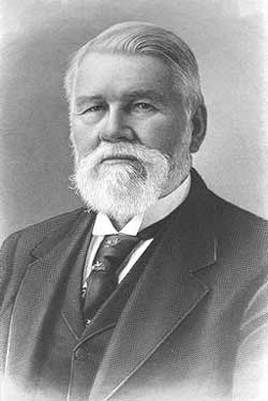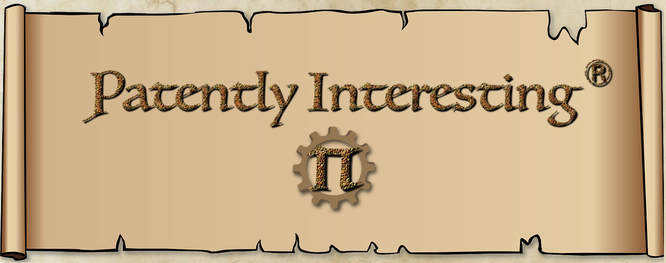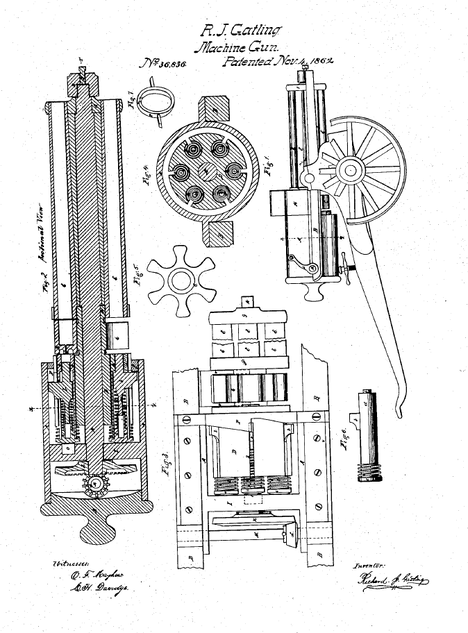 Richard Jordan Gatling
Richard Jordan Gatling
On November 4 of the year 1862, U.S. Patent No.: 36,836 issued to Richard Jordan Gatling for an "Improvement in Revolving Battery-Guns ". It was the patent for the world's first successful rapid firing gun. The abbreviated heading on the first page of the '836 patent also introduced the term "machine gun" into the lexicon of the English language.
Gatling claimed he was motivated to create his invention by a desire to reduce human suffering. In the early stages of the Civil War, Gatling observed that soldiers mostly died from disease instead of directly from gunshot wounds. This observation prompted Gatling to develop his machine gun ostensibly in order to reduce the carnage of war. His reasoning is set forth in a passage he wrote in 1877: "It occurred to me that if I could invent a machine – a gun – which could by its rapidity of fire, enable one man to do as much battle duty as a hundred, that it would, to a large extent supersede the necessity of large armies, and consequently, exposure to battle and disease [would] be greatly diminished."
In accordance with his stated desire to reduce human suffering, Gatling was a medical doctor. Gatling, however, never practiced medicine. Instead, Gatling preferred to invent. Before inventing his machine gun, Gatling had invented a rice-sowing machine, a wheat drill and a steam plow. After the onset of the Civil War, Gatling turned his attention to firearms.
After coming up with his initial idea for a machine gun, Gatling was able to quickly build a prototype by the end of 1861. The gun had six barrels fixed relative to each other in a cylindrical arrangement, which was rotatable around a central axis. A top loading magazine fed cartridges into the barrels as the barrels were rotated around the central axis by a hand crank. A firing mechanism would automatically fire a cartridge after it was loaded into a barrel. As such, the firing rate of the gun was only limited by the speed with which a gunner could rotate the crank. The initial model of the gun could fire up to 200 rounds per minute, but later models achieved a rate of up to 1,200 rounds per minute.
The U.S. Army favorably tested Gatling's gun in 1863, but the U.S. Army was too conservative to purchase the gun in any appreciable quantity. As such, the Gatling gun saw only very limited action in the Civil War. The Gatling gun, however, was later used by the U.S. Army against Native Americans and by the British in the Zulu War and the Russians in the Russo-Turkish War. The U.S. Army declared the Gatling gun obsolete in 1911, but its operating concept was resurrected several decades later in the form of the M61 Vulcan, which was used extensively in the Vietnam War.
Gatling claimed he was motivated to create his invention by a desire to reduce human suffering. In the early stages of the Civil War, Gatling observed that soldiers mostly died from disease instead of directly from gunshot wounds. This observation prompted Gatling to develop his machine gun ostensibly in order to reduce the carnage of war. His reasoning is set forth in a passage he wrote in 1877: "It occurred to me that if I could invent a machine – a gun – which could by its rapidity of fire, enable one man to do as much battle duty as a hundred, that it would, to a large extent supersede the necessity of large armies, and consequently, exposure to battle and disease [would] be greatly diminished."
In accordance with his stated desire to reduce human suffering, Gatling was a medical doctor. Gatling, however, never practiced medicine. Instead, Gatling preferred to invent. Before inventing his machine gun, Gatling had invented a rice-sowing machine, a wheat drill and a steam plow. After the onset of the Civil War, Gatling turned his attention to firearms.
After coming up with his initial idea for a machine gun, Gatling was able to quickly build a prototype by the end of 1861. The gun had six barrels fixed relative to each other in a cylindrical arrangement, which was rotatable around a central axis. A top loading magazine fed cartridges into the barrels as the barrels were rotated around the central axis by a hand crank. A firing mechanism would automatically fire a cartridge after it was loaded into a barrel. As such, the firing rate of the gun was only limited by the speed with which a gunner could rotate the crank. The initial model of the gun could fire up to 200 rounds per minute, but later models achieved a rate of up to 1,200 rounds per minute.
The U.S. Army favorably tested Gatling's gun in 1863, but the U.S. Army was too conservative to purchase the gun in any appreciable quantity. As such, the Gatling gun saw only very limited action in the Civil War. The Gatling gun, however, was later used by the U.S. Army against Native Americans and by the British in the Zulu War and the Russians in the Russo-Turkish War. The U.S. Army declared the Gatling gun obsolete in 1911, but its operating concept was resurrected several decades later in the form of the M61 Vulcan, which was used extensively in the Vietnam War.


